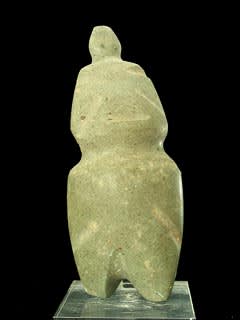Mezcala Stone Standing Figure with a Cap, 300 BCE - 300 CE
Stone
5.5
PF.5431
Further images
The common quest of all civilizations is timeless: survival. While our individual perceptions of the world may change and realities may be altered, since the dawn of man we have...
The common quest of all civilizations is timeless: survival. While our individual perceptions of the world may change and realities may be altered, since the dawn of man we have all yearned to become eternal through procreation and reproduction. This stone sculpture represents this most elementary struggle. Like a miniature Easter Island idol, the figure stands with open legs, folded arms, and protruding jaw and forehead. A small cap crowns his head. The contours of the statue, excluding the crown, echo the form of a phallus. Most likely, this statue would have been used as a pestle to grind up corn or wheat. Thus as the women of the tribe prepared the food, they would have held in their hands the symbol of male fertility, linking the immediate survival of the community through food with the procreation of the species through copulation. All at the same time invoking the favors of the gods. What may be mistaken for a simple carving by primitives, is in actuality a mighty symbol for all that sustains us, for the basic core of human existence.





